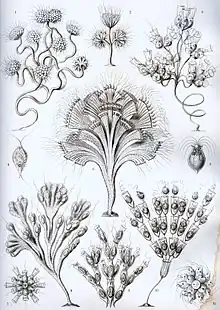Phalansterium
| Phalansterium | |
|---|---|
 | |
| Phalansterium digitatum (figure 8) | |
| Scientific classification | |
| Domain: | Eukaryota |
| (unranked): | |
| Subphylum: | Cavalier-Smith, 1998 |
| Class: | Cavalier-Smith, 2004 |
| Order: | Hibberd, 1983 |
| Family: | Phalansteriidae Kent, 1880-1881 |
| Genus: | Phalansterium Cienkowski, 1870 |
Phalansterium is a genus of single-celled flagellated organisms comprising several species, which form colonies.[1] Phalansterium produces tetraspores.[2]
Phalansterium is hard to classify; it has a distinctive ultrastructure of its pericentriolar material. Molecular evidence places it in the Amoebozoa.[3][4]
It has been suggested that it is similar to the ancestral eukaryote.[5]
Species
Genus Phalansterium Cienkowsky 1870
- Species Phalansterium arcticum Shmakova, Karpov & Smirnov 2018
- Species Phalansterium consociatum (Fresenius 1858) Cienkowsky 1870
- Species Phalansterium digitatum Stein 1878
- Species Phalansterium filosum Cavalier-Smith & Chao 2011
- Species Phalansterium intestinum Cienkowsky 1870
- Species Phalansterium solitarium Sandon 1924
References
- ↑ "Phalansterium". Encyclopedia of Life.
- ↑ Guiry, M.D.; Guiry, G.M. (2008). "Phalansterium". AlgaeBase. World-wide electronic publication, National University of Ireland, Galway. Retrieved 2009-02-21.
- ↑ Thomas Cavalier-Smith, Ema E. -Y. Chaoa and Brian Oates (18 May 2004). "Molecular phylogeny of Amoebozoa and the evolutionary significance of the unikont Phalansterium". European Journal of Protistology. 40 (1): 21–48. doi:10.1016/j.ejop.2003.10.001.
- ↑ Nikolaev, Si; Berney, C; Petrov, Nb; Mylnikov, Ap; Fahrni, Jf; Pawlowski, J (Jun 2006). "Phylogenetic position of Multicilia marina and the evolution of Amoebozoa". International Journal of Systematic and Evolutionary Microbiology. 56 (Pt 6): 1449–58. doi:10.1099/ijs.0.63763-0. PMID 16738126. Archived from the original (Free full text) on 2012-07-09.
- ↑ Cavalier-Smith T (March 2002). "The phagotrophic origin of eukaryotes and phylogenetic classification of Protozoa". Int. J. Syst. Evol. Microbiol. 52 (Pt 2): 297–354. doi:10.1099/00207713-52-2-297. PMID 11931142.
This article is issued from Offline. The text is licensed under Creative Commons - Attribution - Sharealike. Additional terms may apply for the media files.